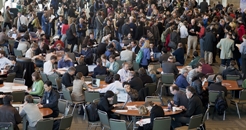 Life changing buildings
Life changing buildings
By Kelvin Sampson, architect Leap Design Group Thame
Architecture has a profound capability of influencing our sense of wellbeing, it provides for down to earth, practical needs such as warmth and shelter, space for functions and activities, be that sitting on a sofa in front of a comforting fire or chasing a shuttlecock, racquet in hand. It can affect our mood;; spaces can engender so many emotions, trigger memories or associations. Our built environment can be oppressive or uplifting, eerie or joyful and so much more.
Our buildings also have the power to speak about us. They speak of culture, technological advancement, climatic differences, about the people who conceived and designed them and then those who currently occupy them. So what do the buildings we occupy or use say about us and how much do they reinforce the message that the people themselves communicate?
When applied to our church buildings, these are important considerations, what makes a good church building? Do the same rules apply today as applied 10 or 100 or 800 years ago? Do our buildings give the same message to passers by today as they did when they were first built? Is it incumbent on us to adapt them to respond to cultural changes or should they stand as testament to the timelessness of our Christian heritage in the UK?
These are challenging questions for the Church.
Is there a right answer, a formulaic building solution? No, I don’t believe there is. As I go from church to church, denomination to denomination, I’m struck by the immense diversity there is in the Christian Church yet every one is an expression of God’s plan for the universe – amazing!
Surely for so diverse an organism that the Church is, it is wholly appropriate that our buildings reflect this creativity and diversity, timeless celebration of its history and future?
Still, the question for each Church in its local environment is the suitability of its buildings wherever they gather, to properly resource its mission, meeting the real needs of the people it is working with.
Life changing buildings are those which are instruments, vehicles, tools for community transformation. Well-conceived buildings begin with a comprehensive understanding of the function they serve. Architects may design incredible spaces, eye-catching designs, iconic and cultural statements but if the designs don’t have people at their heart, they fail in their fundamental objective.
Good design begins with revelation of people’s needs. There needs to be vision and desire to meet these needs. Where revelation and desire overlap, the introduction of creativity and understanding will breathe life into the creation of spaces and allow them to transform lives.
The Christian message is embodied in Jesus’ ministry recorded in the Bible. In perfect balance, Jesus taught about God’s plan for saving people from their wrongdoing, he demonstrated compassion and looked after people’s physical needs and he demonstrated the supernatural rule and reign of God, showing how it can be accessible on earth, even now. This is the mission of the Church; to preach the good news of Jesus, meet people’s needs and perform signs and wonders – an awesome calling!
The Church doesn’t need buildings to fulfil this calling but the outworking of this mission means that there are practical necessities for buildings of different kinds. We think of church buildings as places for worship, somewhere to gather many with order and dignity – that’s what our experience tells us. Perhaps we need to change our mindset of what church buildings are?
What if our revelation of people’s needs shows us that there is isolation and loneliness? Yes, people can find relationship and support by coming to church but why would they come? Instead of investing first in buildings for corporate worship could we invest in buildings to foster community?
What would this look like in our town centres? If there is financial hardship, unemployment, under achievement, what should the Church’s response be and what would our buildings look like? Furniture storehouses, foodbanks, adult education, job clubs, training courses? This building form is a world apart from our traditional congregational church buildings.
I’m convinced the Church should be constantly reevaluating the tools it has available to fulfil its mission. It needs to be contextually and culturally relevant in an ever changing world, responding to real needs (as opposed to a church’s perception of needs) and adapting the resources to suit.
Life changing buildings are those that facilitate community transformation in the hands of people passionate about God’s plan for restoring his creation. Without devaluing the practical needs of a gathered worshipping body of people, it’s time to challenge our understanding of church buildings, in purpose and resultant form. Let’s reengage with our communities, find out the real needs and respond with acts of compassion in buildings that are well equipped to support us.
Image: marekuliasz / Shutterstock.com
Kelvin Sampson, 18/04/2016